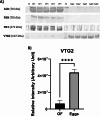Comparative proteomic analysis of the ovarian fluid and eggs of Siberian sturgeon
- PMID: 38714919
- PMCID: PMC11077782
- DOI: 10.1186/s12864-024-10309-y
Comparative proteomic analysis of the ovarian fluid and eggs of Siberian sturgeon
Abstract
Background: Sturgeon species are living fossils that exhibit unique reproductive characteristics, and elucidation of the molecular processes governing the formation and quality of sturgeon eggs is crucial. However, comprehensive data on the protein composition of sturgeon ovarian fluid (OF) and eggs and their functional significance are lacking. To address this knowledge gap, the aim of the present study was to conduct a comprehensive comparative proteomic analysis of Siberian sturgeon OF and eggs using liquid chromatography-mass spectrometry (LC-MS/MS).
Results: A total of 617 proteins were identified in OF, and 565 proteins were identified in eggs. A total of 772 proteins showed differential abundance. Among the differentially abundant proteins, 365 were more abundant in OFs, while 407 were more abundant in eggs. We identified 339 proteins unique to OFs and 287 proteins specific to eggs, and further investigated the top 10 most abundant proteins in each. The functional annotation of the OF proteins highlighted their predominant association with immune system processes, including the complement and coagulation cascade, neutrophil and leukocyte-mediated immunity, cholesterol metabolism, and regulation of the actin cytoskeleton. Analysis of egg proteins revealed enrichment in metabolic pathways, such as oxidative phosphorylation and fatty acid metabolism, and protein ubiquitination and translation. OF-specific proteins included extracellular matrix and secretory vesicles, and eggs were enriched in proteins localized to mitochondria and ribosome components.
Conclusions: This study presents the first comprehensive characterization of the protein composition of sturgeon OF and eggs and elucidates their distinct functional roles. These findings advance our understanding of sturgeon reproduction, OF-egg signaling and the origin of OF proteins. The mass spectrometry proteomics data have been deposited in the ProteomeXchange Consortium with the dataset identifier PXD044168 to ensure accessibility for further research.
Keywords: Acipenser baerii; Eggs; Mass spectrometry; Ovarian fluid; Proteome.
© 2024. The Author(s).
Conflict of interest statement
The authors declare no competing interests.
Figures







Similar articles
-
Identification of the origin and localization of chorion (egg envelope) proteins in an ancient fish, the white sturgeon, Acipenser transmontanus.Biol Reprod. 2014 Jun;90(6):132. doi: 10.1095/biolreprod.113.116194. Epub 2014 May 7. Biol Reprod. 2014. PMID: 24804966
-
Determination of cortisol in lake sturgeon (Acipenser fulvescens) eggs by liquid chromatography tandem mass spectrometry.J Chromatogr B Analyt Technol Biomed Life Sci. 2017 Jan 1;1040:162-168. doi: 10.1016/j.jchromb.2016.11.028. Epub 2016 Nov 23. J Chromatogr B Analyt Technol Biomed Life Sci. 2017. PMID: 27984758
-
Comparison of proteomic profiles in the ovary of Sterlet sturgeon (Acipenser ruthenus) during vitellogenic stages.Comp Biochem Physiol Part D Genomics Proteomics. 2018 Sep;27:23-29. doi: 10.1016/j.cbd.2018.04.006. Epub 2018 May 2. Comp Biochem Physiol Part D Genomics Proteomics. 2018. PMID: 29738886
-
Evolutionarily conserved ovarian fluid proteins are responsible for extending egg viability in salmonid fish.Sci Rep. 2024 Apr 26;14(1):9651. doi: 10.1038/s41598-024-60118-2. Sci Rep. 2024. PMID: 38671194 Free PMC article.
-
Proteomics: A valuable approach to elucidate spermatozoa post -testicular maturation in the endangered Acipenseridae family.Anim Reprod Sci. 2018 May;192:18-27. doi: 10.1016/j.anireprosci.2018.03.033. Epub 2018 Mar 31. Anim Reprod Sci. 2018. PMID: 29622351 Review.
Cited by
-
Cryoprotectant-specific alterations in the proteome of Siberian sturgeon spermatozoa induced by cryopreservation.Sci Rep. 2024 Jul 31;14(1):17707. doi: 10.1038/s41598-024-68395-7. Sci Rep. 2024. PMID: 39085328 Free PMC article.
-
Transcriptomic Analysis Provides New Insights into Oocyte Growth and Maturation in Greater Amberjack (Seriola dumerili).Animals (Basel). 2025 Jan 24;15(3):333. doi: 10.3390/ani15030333. Animals (Basel). 2025. PMID: 39943103 Free PMC article.
-
Metabolomics in sturgeon research: a mini-review.Fish Physiol Biochem. 2024 Aug;50(4):1895-1910. doi: 10.1007/s10695-024-01377-8. Epub 2024 Jul 9. Fish Physiol Biochem. 2024. PMID: 38980504 Free PMC article. Review.
References
-
- Bemis WE, Birstein VJ, Waldman JR. Sturgeon biodiversity and conservation: an introduction. In: Birstein VJ, Waldman JR, Bemis WE, editors. Sturgeon Biodiversity and Conservation. Developments in Environmental Biology of fishes. Dordrecht: Springer; 1997. pp. 13–4.
-
- Kholodnyy V, Gadêlha H, Cosson J, Boryshpolets S. How do freshwater fish sperm find the egg? The physicochemical factors guiding the gamete encounters of externally fertilizing freshwater fish. Rev Aquacult. 2019;12(2):1165–92. doi: 10.1111/raq.12378. - DOI
Publication types
MeSH terms
Substances
Grants and funding
LinkOut - more resources
Full Text Sources
Research Materials
Miscellaneous

